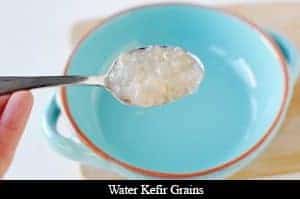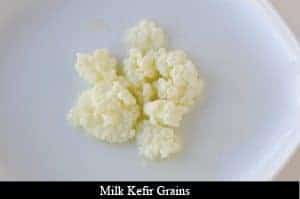Making Kefir: Milk Kefir and Water Kefir
USING KEFIR FOR EXCELLENT DIGESTIVE HEALTH AND IMMUNE FUNCTION

My entire family stopped getting sick, and never again got a flu or bacterial infection, when we made it a daily habit to eat homemade cultured foods.
(Specifically, I made a habit of using milk kefir grains, with raw goat milk, when my kids were little. Later, and to this day, I quickly and easily “culture” coconut juice, using water kefir grains--and I use it as the base of smoothies instead of water.)
Many modern health problems are related to a lack of healthy organisms in the digestive tract. And these billions of teeming flora are our main protection against viruses and bacteria. People who have taken antibiotics have severely depleted healthy flora, which leads to getting sick over and over, inflammation in the gut causing many modern diseases, and an inability to digest foods and utilize nutrition.
Step 8 of my 12 Steps to Whole Foods is about how to culture foods.
The easiest, least-expensive way to get live, fermented (or “cultured”) foods into your diet is to make homemade kefir. It tastes much like yogurt, but has even higher numbers and a broader range of beneficial microorganisms than yogurt does. And it doesn’t require any cooking—so, it’s simpler to make.
You can drink kefir plain. I made a smoothie for my children with milk kefir every morning, blended with bananas and berries.
For me and John, and when my adult kids are in town, I use coconut-water kefir every morning as the base of my Hot Pink Breakfast Smoothie (see Ch. 11 of 12 Steps to Whole Foods). (You may see coconut juice called coconut water or coconut liquid--they’re all the same thing. Coconut milk or coconut cream are different things--don’t use those for this easy habit I’m about to tell you; they are great products for other uses, but are much higher in fat and calories.)
You can use fermented coconut water to ferment grains (like wheat, oats, or rye) for sourdough bread or any baking recipe, breaking down wheat or other grains and making them far easier to digest. Use it as part of the liquid called for in your recipe.
An extra step in any baking recipe that is beneficial for your health is to soak the water/kefir (about 5:1 ratio) in flour or other forms of whole grains, 8 to 24 hours in advance of making the recipe.
A note about milk kefir: sometimes, especially in hot weather, a clear yellow liquid separates from the milk solids in your kefir, which is called whey. Do not throw this mineral-rich, nutritious liquid away. You can drink it plain or in a smoothie. It can be used – 2 Tbsp. in a cup of water – to ferment a quart of raw cabbage to make sauerkraut that will last 2+ years, covered, with no boiling-water-bath or pressurized canning. It can also be diluted with 5 parts water as a tree or plant/shrub fertilizer!
Let me explain what “kefir grains” are. They are similar to the “mother” in kombucha (another fermented product). They are a colony of living, probiotic organisms, which not only nourish the human gut microbiome, they also act on liquids like dairy milk, coconut liquid, or almond milk, to “ferment” it, or “culture” it. Cultured milks last much longer in your fridge than unfermented milks do, because the culturing has a preservation effect. But for the purposes of this article, I’m interested in teaching you how to make kefir successfully, because it’s so great for your gut health. I want to teach you how I make “water kefir” of coconut liquid, because it has enough natural sugars in it, that you don’t have to add processed sugar, like many people do, in most of the instructions you read online to make kefir.
You can definitely make a nutritionally powerful, gut-health-protective kefir drink, without adding sugars to your diet!
First of all, to purchase water kefir grains, click here. For milk kefir grains, click here.
How To Make Milk Kefir

Step 1
Put 2-4 Tbsp. kefir grains in a clean glass jar. (These can be right from the package you purchased, of kefir grains. Then, ongoing, the “grains” will grow and multiply, and you can just keep the growing amount in use every day. Just give some away to a friend, when the grains grow to be bigger than you can use!)
Step 2
Pour 2 cups fresh milk over the grains (at room temperature, not cold from the fridge, which shocks the grains). Stir gently. It’s best to use raw, whole milk, that has not been treated with hormones. Cover with a lid or tea cloth and let sit at room temperature for 24-36 hours. Shake or stir it once a day. The kefir will smell tangy and the mixture will be thick when it is done. You can let it ferment a shorter or longer time according to your tastes.
Step 3
Pour cultured milk through a fine-mesh strainer. The kefir grains will remain in the strainer. Scoop them into your next batch of fresh milk to begin again. Do not rinse the grains; it’s okay if some of the kefir goes into the next batch. Scraping and rinsing your live kefir grains traumatizes them.
How To Make Water Kefir
Step 1
Put 2-4 Tbsp. kefir grains in a clean glass jar. Pour 3 cups coconut liquid in the jar, or 3 cups of filtered water. I like to use coconut liquid (also called juice, or water) because the natural sugars in the liquid give the kefir grains their “food,” so you don’t have to add any sugar, for a perfect product.
Step 2
If you are using water, add ¼ cup honey, organic Sucanat or coconut sugar, or raw, organic agave. Optionally, add 1 tsp. molasses or a piece of an organic eggshell.
Step 3
(Your grains will thrive on minerals, and the eggshell or molasses is mineral-rich.) Stir gently, then cover with a lid and let sit at room temperature for 3-5 days.
Step 4
Taste it, and if it is very sweet, it needs to ferment longer. (Fermentation consumes the sugars. However, while you will read all over the internet that you don’t need to worry about sugars in this fermented product, I disagree that the process really consumes all of the sugar, because it still tastes sweet.)
Water kefir can ferment for many days, even up to two weeks, if you want a very tart-tasting product that is even higher in probiotics. (Watch it carefully, because in a very hot and humid climate, it may eventually mold.)
Kefir made from coconut liquid should be refrigerated after about 2 days, as it ferments quickly.
I recommend keeping a quart jar of water grains in sugar-water or coconut water on the counter. And just drain the liquid off it every one to three days, in something you make regularly, like a smoothie recipe.
You can also take a few spoonfuls out of your water kefir once a week, to use in your coconut liquid. This method lets you constantly grow your water grains, so you can share with others and help them improve their health.
Water grains proliferate like rabbits and guppies, much faster than milk grains! Consume your extra (in a smoothie) or give it away.














